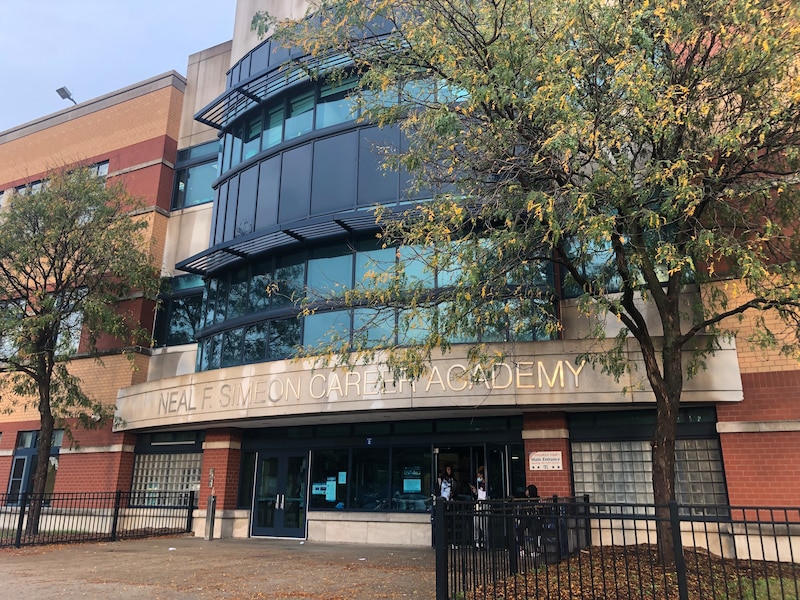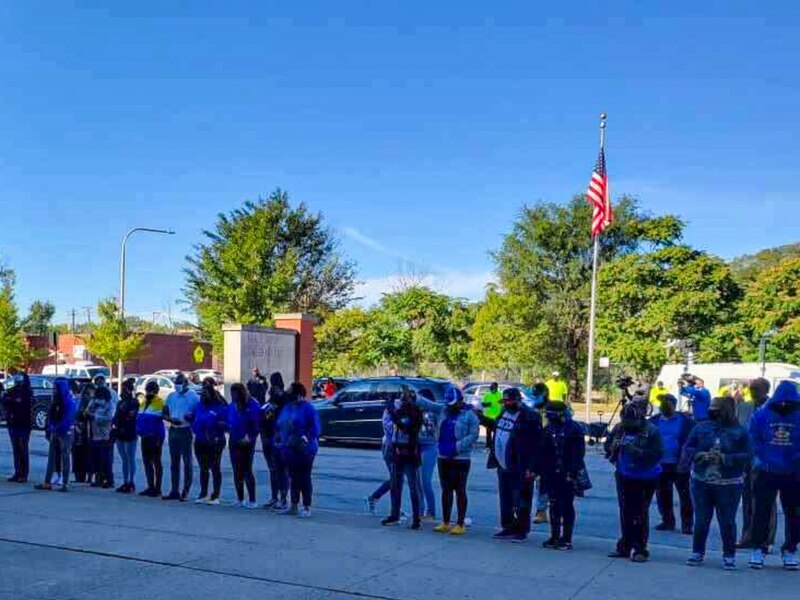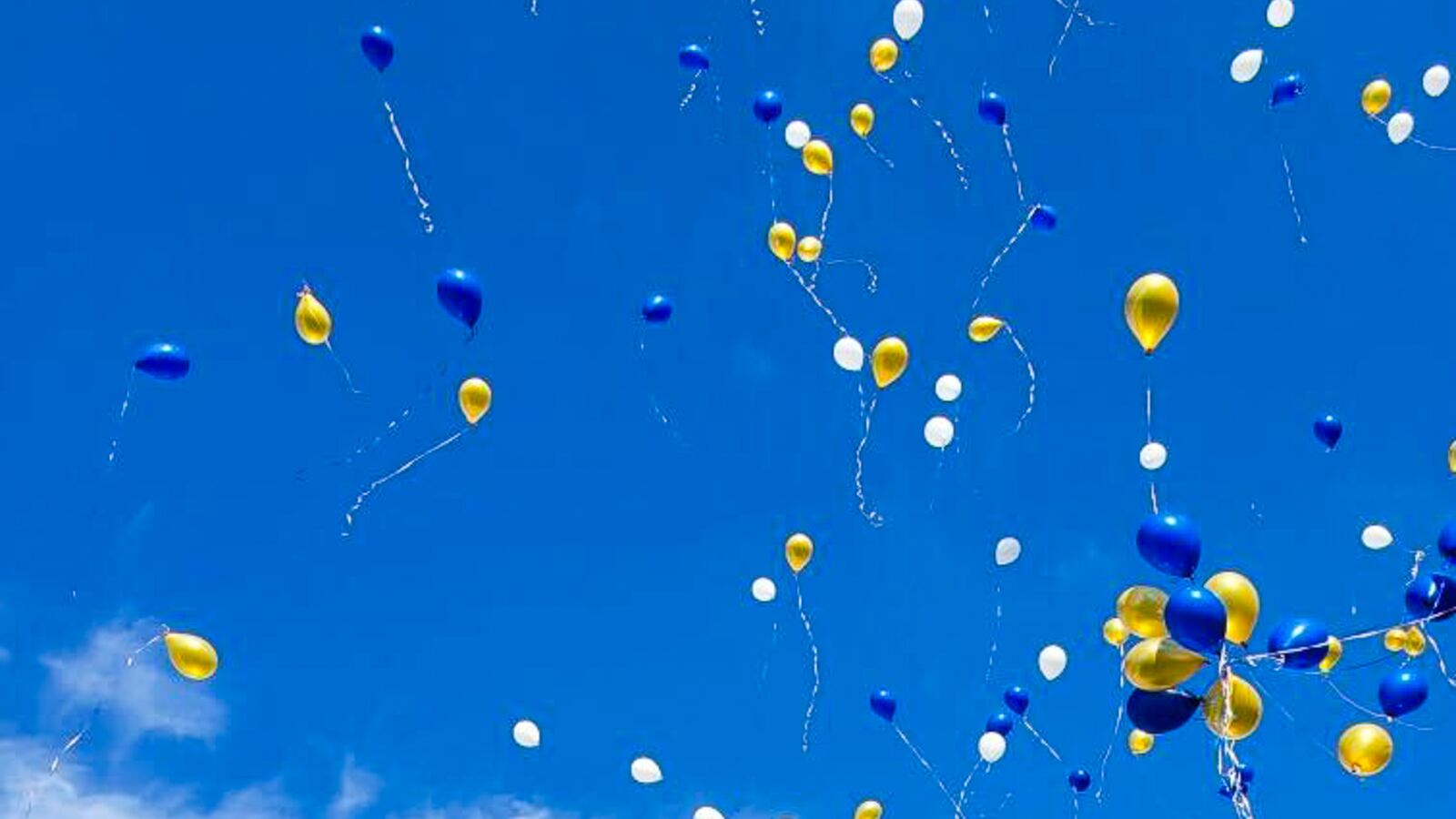Word reverberated through Simeon Career Academy — in hushed conversations in living rooms and kitchen tables, through frantic announcements at drumline practice, over text messages among friends:
Jamari Williams, a 15-year-old sophomore at Simeon, had been shot and killed after school just blocks away at a nearby shopping center — a typical hangout for students.
A few hours later about six miles away, Kentrell McNeal, another 15-year-old Simeon freshman, was shot outside a Hyde Park McDonald’s before dying at a nearby hospital early the next morning.
Staff and students buoyed one another to get through the tumultuous days and weeks that followed the back-to-back shootings on Sept. 21. A balloon release and vigil gave the community a chance to grieve. Chicago Public Schools dispatched extra counselors and social workers and worked with outside groups to provide mental health support.
But much of that attention soon faded.
Students, staff, and alumni interviewed by Chalkbeat indicated things at the tight-knit Chatham high school seemed to return to normal by the holidays.
For some, the shock of losing classmates waned, replaced with numbness at yet another student shot and killed. For others, the heartache has lingered, even as the first anniversary of the shootings approaches.
Grief also spread beyond Simeon’s borders — to other schools where Jamari and Kentrell had friends and families and to other campuses where students have been lost or injured in Chicago’s pervasive gun violence.
Last year, more than 50 school-aged children were shot and killed and hundreds more were wounded, according to the Chicago Sun-Times. Since January, 38 people 17 and younger have been shot and killed this year.
And, just three days into this new school year, four Schurz High School students sitting at an ice cream shop patio across from the campus were injured — two critically — in a drive-by shooting. In the week after the shooting, CPS and the Chicago Police Department offered additional safety support before and after school and the district’s crisis teams and counselors provided healing circles and one-on-one therapy.
But the district must do more than flood a campus with resources in such moments of tragedy, say students, staff, and community members at Simeon. A one-time crisis response is just not enough. Instead, they say, schools need proactive, sustained mental health support to help all students — at all times.
Students walk through the halls of Chicago schools carrying “so much trauma,” said Jamari’s cousin Catlyn Savado, who attends Julian High School. “It’s just really, really, really bad.”
Chicago Public Schools CEO Pedro Martinez has repeatedly acknowledged the problem and vowed to address it.
“We see it every week,” Martinez said during a press conference in October two weeks after a shooting outside Phillips Career Academy that left a 14-year-old student and a security guard injured.
“We can’t ignore it,” Martinez said. “We have to join together. We need to provide these services to students that really need it.”
In 2019, Janice Jackson, the district’s former CEO, spoke before Congress, asking for more funding to address childhood trauma.
Children exposed to trauma are at higher risk of lower grades, poor attendance, behavior problems, and dropping out, Jackson said during the hearing. Trauma can also trigger mental health issues and substance abuse, she added.
Now, a flood of federal dollars has given Chicago Public Schools an opportunity to spend money to address the mental health impacts not only from COVID, but also from the city’s other pandemic:
The trauma of gun violence.

Simeon searches for healing after shootings
Jamari and Kentrell used sports as a refuge, the Sun-Times reported.
Kentrell loved basketball, while Jamari dreamed of giving his family a better life through football, a pastor told Block Club Chicago.
But even before their deaths, both teens had also been deeply impacted by gun violence. Shortly before his death, Jamari lost his father to gun violence. Kentrell was a member of GoodKids MadCity, a youth organization that fights to end violence.
Following their deaths last fall, Chicago Public Schools dispatched crisis teams to Simeon. Some counselors followed Jamari’s and Kentrell’s class schedules, offering support to their peers.
The school also partnered with organizations such as Bright Star and New Root Learning Institute for additional support that included group therapy sessions and healing circles. Dozens of students who witnessed Jamari’s shooting received additional support, principal Dr. Trista Harper told LSC members in October.
Harper, who described the incident as one of the “worst days” of her career during that meeting, declined multiple requests for interviews to discuss the school’s response.
“There were so many kids that needed help,” student Jamal Anderson recalled a few months later.
In a statement, Chicago Public Schools said it takes the health and well-being of its students seriously.
“The District staffs schools with the resources needed to foster a welcoming learning environment,” the district statement read. “Simeon Career Academy has a Behavioral Health team and two full-time social workers, along with two mental health partners for additional support.”
As part of the 2023 budget, the district plans to implement a curriculum “rooted in trauma-informed practices and a restorative approach to student discipline.” It is also working to expand the idea of school-level “care teams” across all schools.
These teams establish a core group of building staff as a frontline response for struggling students. Along with trained crisis counselors and social workers, they help deal with crises including the loss of classmates from gun violence. Simeon has all of these positions now.
But Simeon student London Carter, 17, said the school needed outside counselors more readily available sooner. Some students don’t feel comfortable speaking openly about their trauma with school counselors and would prefer outside professionals for those types of services, she said.
“We need more people to talk to about this,” London said.
Part of the problem, many in the Simeon community said, is that the need is so much greater at a time when students are already dealing with waves of stress and loss spurred by the coronavirus pandemic.
New Root Learning Institute, formerly known as Umoja Student Development, was already working with the school on restorative programs and student engagement prior to the shootings.
Kristin Moore, New Root director of impact, was at the school to help with the district’s crisis response, and noted the back-to-back shootings hit students hard.
“It affected students in a way that I don’t think the adults were really ready to deal with,” Moore said, noting the situation was not unique to Simeon.
“They’re not just dealing with this in school,” Moore said. “This is happening in their neighborhoods. A lot of times these things that happen in schools are related to things happening in their neighborhoods.”
“They’ve experienced a lot of trauma, a lot of death, and it’s almost as if they just sweep it under the rug,” Moore said. “And then one small event happens and it’s almost an explosion.”
Trauma of one incident can ripple through multiple schools
“Here we go again.”
That’s what Chris Thrower recalls thinking when he heard about Jamari’s death.
The former Simeon Local School Council student representative, who graduated in June, said the loss brought back personal memories from when one of his friends was shot and killed his junior year.
“Why do we got to keep going through this?” Thrower said.
Catlyn Savado learned through a text message that her cousin Jamari had been shot and killed.
The 15-year-old sophomore remembered how hard it was to process.
Even as Simeon students and staff received crisis support in the immediate aftermath of Jamari and Kentrell’s deaths, Catlyn had no access to it. She recalled some of her school’s administrators asking if she was OK, but ultimately she didn’t receive any mental health services.
A shooting may hit hard at one school, Catlyn said, but people rarely acknowledge how far the pain caused by gun violence can spread: “Yes, this shooting happened at Simeon, but we have kids at Morgan Park, we have kids at Julian, we have kids at Fenger who are all affected by this.”
Beyond simply responding to the aftermath of a shooting, Catlyn said, the district and the city need to invest in children and young people now.
“We are living now,” Catlyn said. “Invest in the fact that we’re breathing.”
CPS leaders are planning to leverage the district’s $2.8 billion stimulus haul to do just that. In spring 2021, district leaders unveiled a $30 million healing plan for students. It will expand care teams to all 500-plus CPS campuses over the next three years. The money will also pay for 50 to 60 schools to partner with organizations that specialize in mental health and widespread trauma training for educators.
It’s not clear what will happen when stimulus money runs out.

Parents, teachers, alumni pick up where the district falls short
In the immediate days after the shooting, parent Keshia Spraggins was among hundreds of parents who kept their children home.
She remembers hugging her son tight and having hard talks with him about the rise of gun violence and the pain left in its wake.
Spraggins wanted to make sure her son, a junior at the time, was OK — physically and mentally. The message she wanted to impart to her son: You do not have to try to be strong. You do not have to try to carry the weight of all of the violence.
“That’s tough as an adult to deal with,” Spraggins said. ”But as a 15- and 16-year-old, they’re still trying to navigate through life. That’s a lot.”
For many years, she tried to shield her son from the gun violence, but when he returned to school last fall they had to confront the topic head-on.
On the first day of football practice, about a month before the shootings, Spraggins’ son and his teammates were rushed off the field after hearing gunshots. Afterwards, parents would park near the field during practice to keep watch, she said.
In a town hall last fall with Simeon parents, Mayor Lori Lightfoot and Chicago Police Superintendent David Brown promised increased police presence during dismissal to assuage the fears of the school community.
Inside the school, the deaths of Kentrell and Jamari weighed heavily on wary teachers already navigating a tumultuous few years.
Four years ago, then-principal Dr. Sheldon House was ousted from Simeon after the Tribune’s Betrayed series on sexual assault investigation. An internal investigation revealed systemic issues in how the school handled volunteer background checks. The initial investigation found school leadership failed to effectively safeguard students.
Since June 2018, Simeon has had two different principals following House’s removal.
The fall shootings were yet another shock. Between September and May 2022, at least seven teachers resigned from Simeon, according to data obtained by Chalkbeat.
The district’s response was rote — a standard typically given after a student is shot and killed — and just not enough, especially in a year when students were also dealing with the effects of the pandemic, according to teachers who spoke with Chalkbeat on the condition of anonymity for fear of retaliation from the school’s administration.
Simeon alum Kenyatta Starks knows the anguish of losing students to gun violence. She remembers losing six students during her time as principal of Harper High School in Englewood a decade ago.
When a shooting happens, district and school leadership need to also provide support to teachers and staff who are on the frontline with their students, Starks said.
“I think that is the biggest gap,” Starks said. “If we don’t equip them with the social emotional support and training to support students, we are going to continue being this hamster on a wheel.”
Teachers have to replay these conversations several times a day, said John Michael Johnson, organizer of Project Simeon, which helped organize last fall’s balloon release outside of the school.
“We need to train the trainer,” Johnson said. “It needs to be institutionalized and part of professional development. It needs to be ongoing. Because if it’s not, it may not manifest itself for weeks or months.”
Project Simeon, founded as a way to forge ties between students, administrators, alumni, and the faith community, has been working with other alumni groups to foster a supportive community around the school. But over time, Johnson says they’ve had to shift some of their focus to help raise money to support families with burial costs.
The scars of a shooting heal over time but that trauma stays with a community, Johnson said.
“It’s going to take more than prayers to help solve issues around gun violence,” he said.
Johnson thought back to the balloon release in late September. It was a moment of healing and coming together.
As he watched hundreds of blue, gold, and white balloons drift above the school’s majestic building, Johnson said he thought about Jamari and Kentrell — and all the others lost to gun violence.
He thought, too, about the work left to be done.
“You may exhale,” Johnson said, “but you’re still holding your breath.”
Mauricio Peña is a reporter for Chalkbeat Chicago, covering K-12 schools. Contact Mauricio at mpena@chalkbeat.org.

